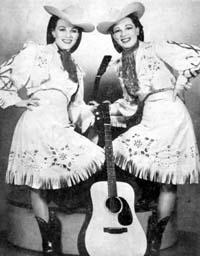| ||

Hillbilly-Music.com—The People. The Music. The History.
|
 |
|||
|
About the Group
About The Group An old 1946 article described them as the '...two most beautiful hillbillies in the East.' They were said to look like twins, but in reality, were not. But they were sisters. Pat was the older one, blue-eyed and a bit business-like. Linday was the younger one by a couple years and on the artistic side. Their parents were in the decorating and importing business. Their parents also patronized the "higher arts". To their surprise, the girls took a liking to the color and vitality of what was known as hillbilly music back then, the dress, the singing, even the rope spinning. Their father was a tad bit upset about their musical leanings - he was hoping they would want to carry on the family business. They could also do comedy work. Maybe that aspect happened by accident. But still, they were astute enough to recognize the value in that accident. The girls reportedly had made a 'creaking entrance' on a garden compost wagon and sung the old folk song Clementine in a sad way, complete with props that included gravestones and flowers and were ready to make a quick exit after their number. However, when Pat grabbed the wheelbarrow, Lindy wasn't ready for Pat to move on - she literally fell into the wagon, and exposed her big shoes, orange striped stockings and pantalettes. The audience roared its approval and laughter. Think they didn't keep comedy in their act after that? They continued to pursue their musical career. They studied at the Emerson College of Drama and Radio. In fact, they worked for a time at the school as assistant directors in theater design. They joined an unnamed "hillbilly troupe" and toured the New England venues. Their experiences in the tent show circuit increased their popularity to the point where they began to work on their own as an act. No mention is made as to who wrote the 1946 article, but before you become enamored with the life of an entertainer, the article gives us a flavor of what the artists back then put up with.
"Performance after performance of banging their big guitars up narrow ladders to a shaky platform on a truck, the microphone whistlin, and the lights burning out, plus damp marsh air and swamrs of mosquitoes, were all climaxed by the show's collapsing when a rain storm blew down the tent." The sisters worked at the various venues common to that era - organizations, night clubs and theaters. Their free time was not spent idly. They worked with their local Red Cross and entertained the troops at the local Army and Navy hospitals and those performance provided their own vivid memories. They were scheduled to perform at the Portsmouth Naval facility on a cold wintery night. One of the boys was on the 'danger list'. The captain at the facility considered canceling the show, but the other boys in the hospital displayed their disappointment to the captain of his thoughts. He relented and let the show go on. Pat and Lindy's show brightened the spirits of those troops and the one sick boy - well, he got out of his room when he heard their singing and was able to see them and smiling at that. It helped him recover a bit and in a few days he was sleeping and resting comfortably. Another personal appearance took them to Camp Edwards and found them dining at the Red Cross facility at the camp. An ex-professional dancer limed in to the facility and started to argue against having those shows at the Camp. Ever since the doctor had told him he would not be able to dance again, he had decided not to attend another show. The girls started to discuss various dance techniques with him. As the conversation went on, he at one point put down his crtuch and starting doing the dance steps he was talking about to prove he was right. On the Hickory Sisters' show that night, he not only attended the show, but he was a part of it. In 1946, they were teaming up with acts from the South and West and were going to tour the Eastern "Dude Ranches" in the summer. The girls had other interests besides music. Horses were one of them. In fact, they managed the Morgan stables for two years at a Vermont guest ranch. Other tidbits we learn from that 1946 feature article - they made little model horses, collected spurs and guns, designed their own stage costumes as you see in the photo and were compiling a book of their own songs. We would be remiss if we would not tell you that on several occasions, we have been contacted by people in the Boston, Massachusetts area that tell us one of the sisters owns a shop on Boylston Street. When the conversation about music comes up, she always pulls out her scrapbook of the career of the Hickory sisters and the mementoes they shared and kept. Credits & Sources
|